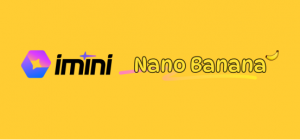iMini integrates Nano Banana Free: A new era of AI image generation
Nano-Banana model is on imini
NY, UNITED STATES, September 11, 2025 /EINPresswire.com/ -- Google’s latest lightweight image generation model, Nano-Banana (Gemini 2.5 Flash Image), is quickly becoming one of the most talked-about AI tools overseas. With millisecond-level response times, a price tag of just $0.039 per image, and advanced features like character consistency and multi-image fusion, the model has been hailed as an “efficiency revolutionizer” in industries ranging from e-commerce design to creative content production.But the real story may not be just about Nano-Banana’s raw capabilities. Increasingly, the platforms that can integrate and contextualize such models are the ones unlocking their true value. One standout example: iMini AI (imini.com), a fast-growing general-purpose agent platform that went viral in August. By embedding Nano-Banana into its multi-agent ecosystem, iMini is reframing what AI image generation looks like in practice.
Why Nano-Banana Matters
At its core, Nano-Banana is all about speed and accessibility. Unlike heavyweight diffusion or transformer-based image models, its parameters are heavily compressed, enabling it to run on mobile devices and lightweight GPUs without performance drops.
The result:
·Seconds, not minutes. Whether it’s editing an image or generating from scratch, output is nearly instant.
·Natural language editing. Users can type commands like “Change the sweater to red, background to sunset beach” and get pixel-consistent results.
·Character stability. With a 90%+ success rate in keeping faces and identities consistent, it solves a common flaw in earlier generation models.
·Multi-image fusion. Nano-Banana can interpret the semantic relationships among multiple inputs, producing new scenes with logical lighting and composition—a game-changer for e-commerce material creation.
·For many, it’s the first time a cutting-edge AI model feels fast, cheap, and reliable enough for day-to-day workflows.
iMini’s Play: Turning a Tool into an Ecosystem
While Nano-Banana is impressive, its adoption has been hampered by friction. Account registrations, subscription hurdles, and raw API integrations put it out of reach for non-technical users.
That’s where iMini AI steps in. Instead of treating Nano-Banana as a standalone API, iMini has wrapped it into a general-purpose agent framework that lowers the barrier to entry and expands use cases.
·Seamless Access. iMini standardizes Nano-Banana’s APIs into services accessible through a simple credit-based system. Sign up, upload an image, and input commands like “Generate a 3D collectible figure”. The system handles the rest—no manual API calls required.
·Scenario Expansion. Unlike a pure image tool, iMini places Nano-Banana inside a “perception–understanding–planning–execution–optimization” loop. That means it doesn’t just create images—it becomes part of multi-step workflows. For example, a request like “Build an industry analysis deck for EVs” gets decomposed into subtasks: web scraping for data, analysis, chart creation (via Nano-Banana), and formatting. The end product is a business-ready, polished PPT.
·This shift—from “single task” model to multi-agent workflow integration—is what gives iMini its competitive edge.
From Models to Agents: A Broader Industry Shift
What we’re witnessing is a broader paradigm shift in AI. The next frontier isn’t about who builds the most powerful standalone model, but who can:
1.Integrate multiple models effectively
2.Adapt them to real-world scenarios
3.Orchestrate them in a way that saves users time
In e-commerce, that might mean:
·Nano-Banana generates product visuals
·An NLP agent drafts marketing copy
·A data agent scrapes competitor insights
·Together, iMini compresses a week’s worth of work into minutes.
The trajectory is clear: as RISC-V chips and in-memory computing architectures drive faster, more efficient on-device AI, platforms like iMini are laying the groundwork for ubiquitous, adaptive intelligent agents—the kind that can learn user habits, evolve over time, and embed seamlessly into IoT ecosystems.
The Bottom Line
Nano-Banana may be Google’s flashiest AI release of the year, but the real disruption lies in how platforms like iMini operationalize it. The next phase of the AI race won’t be won by raw model benchmarks, but by the ecosystems that can bridge user needs, model power, and hardware constraints into seamless, scalable services.
In short: the age of intelligent agents has begun, and the companies that master integration, not isolation, will be the ones to lead it.
Mo Chen
imini ai
email us here
Legal Disclaimer:
EIN Presswire provides this news content "as is" without warranty of any kind. We do not accept any responsibility or liability for the accuracy, content, images, videos, licenses, completeness, legality, or reliability of the information contained in this article. If you have any complaints or copyright issues related to this article, kindly contact the author above.




